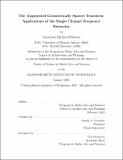| dc.contributor.advisor | Joseph A. Paradiso. | en_US |
| dc.contributor.author | Feldman, Jonathan Michael,S.M.Massachusetts Institute of Technology. | en_US |
| dc.contributor.other | Program in Media Arts and Sciences (Massachusetts Institute of Technology) | en_US |
| dc.date.accessioned | 2021-06-17T17:21:16Z | |
| dc.date.available | 2021-06-17T17:21:16Z | |
| dc.date.copyright | 2021 | en_US |
| dc.date.issued | 2021 | en_US |
| dc.identifier.uri | https://hdl.handle.net/1721.1/131006 | |
| dc.description | Thesis: S.M., Massachusetts Institute of Technology, School of Architecture and Planning, Program in Media Arts and Sciences, February, 2021 | en_US |
| dc.description | Cataloged from the official PDF version of thesis. | en_US |
| dc.description | Includes bibliographical references (pages 99-103). | en_US |
| dc.description.abstract | The Augmented Geometrically Spaced Transform (AGST) is an auditory model that is based on an inversion of the acoustic piano, where the piano produces music and the transform analyses it. In contrast with the standard spectrogram, which is a complex frequency vector versus time, the AGST is based around a matrix of frequencies, known as the AGST Frequency Matrix, where for every frequency in the matrix, a spectral envelope is computed using a Single Channel Frequency Estimator (SCFE). The core invention of the thesis is the algorithm for the SCFE, which computes spectral envelopes with maximally high definition in a computationally efficient manner. A bank of SCFEs is assembled into a constant Q transform, known as a Geometrically Spaced Transform (GST). The GST can be used to visualize harmonics inside of musical notes, or audio in general, in a constant Q fashion. It is then shown that the AGST is a good front-end model for computational pitch perception. For example, it can be used to solve an important problem in auditory perception, the case of the missing fundamental. The entire thesis is framed in the context of building artificially intelligent music systems, including synthetic listeners (machines that listen in the way that people do), and synthetic performers (machines that allow for interactive music performance). | en_US |
| dc.description.statementofresponsibility | by Jonathan Michael Feldman. | en_US |
| dc.format.extent | 103 pages | en_US |
| dc.language.iso | eng | en_US |
| dc.publisher | Massachusetts Institute of Technology | en_US |
| dc.rights | MIT theses may be protected by copyright. Please reuse MIT thesis content according to the MIT Libraries Permissions Policy, which is available through the URL provided. | en_US |
| dc.rights.uri | http://dspace.mit.edu/handle/1721.1/7582 | en_US |
| dc.subject | Program in Media Arts and Sciences | en_US |
| dc.title | The Augmented Geometrically Spaced Transform : applications of the single channel frequency estimator | en_US |
| dc.title.alternative | Applications of the single channel frequency estimator | en_US |
| dc.type | Thesis | en_US |
| dc.description.degree | S.M. | en_US |
| dc.contributor.department | Program in Media Arts and Sciences (Massachusetts Institute of Technology) | en_US |
| dc.identifier.oclc | 1256659362 | en_US |
| dc.description.collection | S.M. Massachusetts Institute of Technology, School of Architecture and Planning, Program in Media Arts and Sciences | en_US |
| dspace.imported | 2021-06-17T17:21:16Z | en_US |
| mit.thesis.degree | Master | en_US |
| mit.thesis.department | Media | en_US |
